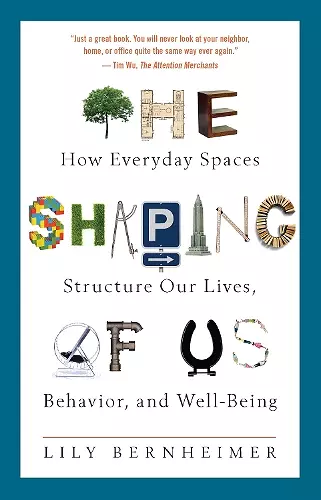The Shaping of Us
How Everyday Spaces Structure Our Lives, Behavior, and Well-Being
Format:Paperback
Publisher:Trinity University Press,U.S.
Published:9th Jun '22
Should be back in stock very soon

The spaces we inhabit– from homes and workspaces to city streets—mediate community, creativity, and our very identity. Using insights from environmental psychology, design, and architecture, The Shaping of Us shows how the built and natural worlds subtly influence our behavior, health, and personality. Exploring ideas such as “ruin porn” and “ninja-proof seating,” mysteries of how we interact with the physical spaces around us are revealed. From caves and cathedrals to our current housing crisis and the dreaded open-plan office, Lily Bernheimer demonstrates that, for our well-being, we must reconnect with the power to shape our spaces.
Have you ever wondered why we adorn our doorframes with moldings? What does Wikipedia’s open-source technology have to teach us about the history and future of urban housing? What does your desk say about your personality?
From savannahs and skyscrapers to co-working spaces, The Shaping of Us shows that the built environment supports our well-being best when it echoes our natural habitats in some way. In attempting to restore this natural quality to human environments, we often look to other species for inspiration. The real secret to building for well-being, Bernheimer argues, is to reconnect humans with the power to shape our surroundings. When people are involved in forming and nurturing their environments, they feel a greater sense of agency, community, and pride, or “collective efficacy.” And when communities have high rates of collective efficacy, they tend to have less litter, vandalism, and violent crime.
Playful and accessible, The Shaping of Us is a delightful read for designers, professionals, and anyone wanting to understand how spaces make us tick and how to fix the broken bits of our world.
"Environmental psychologist Bernheimer provides a fascinating introduction to her field in this far-reaching look at how the spaces in which humans live, work, and play affect their behavior... Readers will finish this feeling better educated about the role of design and more alert to its impact on everyone’s lives."— Publishers Weekly
"Just a great book. Few things matter more than the spaces we inhabit, and Bernheimer convincingly states the case for design that accepts humanity as we actually are. You will never look at your neighbor, home or office quite the same way ever again." — Tim Wu, author of The Attention Merchants and The Curse of Bigness.
“How do our environments—built, natural, and biological—fit or fail to fit our needs as human beings? Lily Bernheimer takes us on a tour, a tour de force, of illuminating cases, with sage advice for those who design spaces for human beings to live humane lives.”— George Lakoff, author of Where Mathematics Comes From: How the Embodied Mind Brings Mathematics into Being
“We have built an urban environment for ourselves, and it shapes us in return. In order to become happier and more effective humans, Bernheimer shows us how we must modify our cities, workplaces, and homes. Her book is an ideal introduction to this essential task.”
— Max Jacobson, co-author of A Pattern Language: Towns, Buildings, Construction
“In this exceptionally readable book, Bernheimer has translated research findings and design practice into a highly engaging account of how we interact with and mold the spaces around us. She shows us that with more thought and imagination, our buildings and cities could provide us with more stimulating, rewarding, and livable environments.” — David Uzzell, professor of environmental psychology, University of Surrey
“You are going to be transported by what Bernheimer has to say. You’ll make different decisions and figure out how your brain is working and what should be prioritized in your life.” — Jo Good, BBC London
“At a time when so much of life is lived online, Bernheimer’s fascinating book offers an accessible, deeply researched, and worldly exploration of the way concrete environments shape how we feel about our lives and the world around us.”— J. K. Dineen, author of Here Tomorrow: Preserving Architecture, Culture, and California’s Golden Dream
“An analysis of how we could design the whole of our environment to be better... She sets out to entertainingly chart the 20th-century history of research into how where we are shapes who we are. It's a timely volume given the current level of interest in the relationship between buildings and health.”— Kevin McCloud, Grand Designs Magazine
ISBN: 9781595349712
Dimensions: unknown
Weight: unknown
336 pages